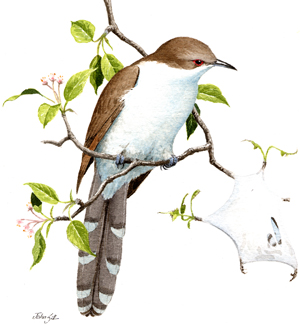Find a Bird
Black-billed Cuckoo
Coccyzus erythropthalmus

Somewhat local and likely declining
Action/monitoring needed
“Summer is a-coming in / Loudly sing cuckoo / Groweth seed and bloweth mead / and springs the wood anew / Sing cuckoo!” – Traditional Folk Song
Cuckoos have long suffered the stigma of being obligate brood parasites – a species that lays its eggs in another species’ nest, leaving the host parents the chore of feeding and raising their young. While it is true that many of the Old World representatives of the family Cuculidae reproduce solely in this fashion, our native cuckoos are actually rather devoted parents. Black-billed Cuckoos are discreet birds that prefer to skulk in brushy tangles and overgrown forest openings, and it is often only by following their calls that they can be located. Though their presence tends to be consistently underestimated because of their reclusive habits, Atlas data suggest that these interesting and beneficial birds may be in decline.
Historic Status
Black-billed Cuckoos have long been a feature of the Massachusetts birdscape. They may have expanded their breeding range northward following human habitation, and as Massachusetts stood at the vanguard of colonization in the New World, the abundance of the bird’s preferred agricultural habitat – specifically orchards –made for a good pairing (Bent 1937). Throughout the nineteenth and early twentieth century ornithologists used the word “common” in reference to the bird in Massachusetts and lauded its caterpillar-killing capabilities. “The Black-billed Cuckoo is, on the whole, one of the most useful birds of farm and orchard and deserves full protection,” wrote Edward Howe Forbush in 1927. The move away from agriculture, though, would eventually shake the Black-billed Cuckoo's foundation in Massachusetts as the twentieth century progressed.
Atlas 1 Distribution
Breeding Black-billed Cuckoos were widely scattered in Atlas 1. The thickets of the northern Marble Valleys had a remarkable density of breeding cuckoos, but the species was otherwise quite local in western Massachusetts. They were locally encountered in suitable habitat across the Connecticut River Valley and the Worcester Plateau into the Coastal Plains. Particular concentrations in the northeastern and southeastern Coastal Plains were likely attributable to regenerating forests as well as the confluence of multiple river systems. The western Boston Basin had breeding cuckoos, and the Bristol/Narragansett Lowlands reflected breeding evidence in more than a third of all blocks. Though less commonly encountered on the Cape and Islands, Black-billed Cuckoos were nonetheless widespread in this region, and were even found at Provincetown and many of the offshore islands.
Atlas 2 Distribution and Change
By the end of Atlas 2, it became obvious that Black-billed Cuckoos were in decline in Massachusetts. The bird’s secretive nature has always made the species difficult to Confirm, and in Atlas 2 few Atlas workers were able to do more than record the species as Possible in many blocks, although the fact remains that the species was also found in fewer places in Atlas 2 than in Atlas 1. The disruptions in distribution were most apparent in eastern Massachusetts, where the bird’s footprint shrank in the Bristol/Narragansett Lowlands and the Coastal Plains, the Boston Basin, and Cape Cod and the Islands. Their only increases in overall sightings occurred in the Berkshire ecoregions. The role of natural cycles of caterpillar abundance in this species’ occupancy patterns is unclear but likely important.
Atlas 1 Map

Atlas 2 Map

Atlas Change Map

Ecoregion Data
Atlas 1 | Atlas 2 | Change | ||||||
Ecoregion | # Blocks | % Blocks | % of Range | # Blocks | % Blocks | % of Range | Change in # Blocks | Change in % Blocks |
Taconic Mountains | 4 | 25.0 | 1.3 | 9 | 36.0 | 3.1 | 2 | 13.3 |
Marble Valleys/Housatonic Valley | 18 | 46.2 | 5.7 | 13 | 33.3 | 4.5 | -5 | -12.8 |
Berkshire Highlands | 13 | 23.6 | 4.1 | 28 | 50.9 | 9.7 | 13 | 24.5 |
Lower Berkshire Hills | 2 | 7.1 | 0.6 | 9 | 29.0 | 3.1 | 7 | 25.9 |
Vermont Piedmont | 2 | 11.8 | 0.6 | 7 | 41.2 | 2.4 | 4 | 33.3 |
Berkshire Transition | 5 | 13.2 | 1.6 | 14 | 35.0 | 4.9 | 7 | 22.6 |
Connecticut River Valley | 17 | 30.4 | 5.4 | 14 | 21.5 | 4.9 | -4 | -8.3 |
Worcester Plateau | 28 | 35.9 | 8.9 | 35 | 39.8 | 12.2 | -7 | -14.6 |
Lower Worcester Plateau | 20 | 27.0 | 6.4 | 24 | 30.0 | 8.3 | -6 | -11.1 |
S. New England Coastal Plains and Hills | 100 | 37.0 | 31.8 | 70 | 24.7 | 24.3 | -39 | -17.3 |
Boston Basin | 22 | 39.3 | 7.0 | 15 | 26.8 | 5.2 | -7 | -12.7 |
Bristol and Narragansett Lowlands | 42 | 39.6 | 13.4 | 16 | 14.0 | 5.6 | -27 | -26.7 |
Cape Cod and Islands | 41 | 30.1 | 13.1 | 34 | 23.6 | 11.8 | -9 | -7.5 |
Statewide Total | 314 | 32.4 | 100.0 | 288 | 27.8 | 100.0 | -71 | -8.6 |
Notes
The Black-billed Cuckoo shows significant decreasing Breeding Bird Survey trends, both in Massachusetts and the New England/Mid-Atlantic region.



